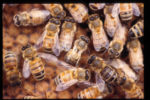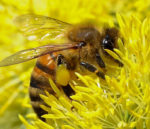The educational materials listed on this page are about Bees.
Apiculture is the management of bees for the purpose of bee breeding, insect pollination and honey production. Honey bees, among other native and non-native bees, are important to agriculture because of their role in crop pollination. Bee pollinated crops will more readily flower and fruit. Aside from bees, there is an entire list of pollinators that aid in serving this important ecological function. One threat to bees are bee diseases. Honey bee diseases can overcome a hive when a pest is introduced, therefore bee pest control is critical. Bee parasites are another threat to bee health, so it is important to find honey bee information that is geared toward your region, climate and other environmental issues. To combat diseases and boost production, some producers have honey bee breeding enterprises to maintain healthy populations. Finally, one of the most important ways to help increase bee production is to grow plants for pollinators. Key practices include pollination, beekeeping, pollinator health, pollinator habitat, honey, cultural control, integrated pest management.
The Cover Crops Topic Room provides information on how to improve crop diversity in order to attract pollinators. Cover Cropping for Pollinators and Beneficial Insects is a helpful bulletin to guide practices that utilize cover crops for multiple beneficial uses, including pollination. SARE’s book How to Manage the Blue Orchard Bee is a resource that provides practical information on best practices for blue orchard bee management to increase orchard production. Managing Alternative Pollinators explains how to manage your farm or ranch to encourage pollinators other than the honey bee.
Showing 1-2 of 2 results

An Introduction to Honey Bee Breeding Program Design
Honey bee breeding is a long-term, labor-intensive process that is becoming more popular and accessible. This 10-page fact sheet from Penn State Extension, An Introduction to Honey Bee Breeding Program Design, introduces beekeepers to the basics of starting a honey bee breeding program.

Native bees and flowering cover crops
While managed colonies of European honey bees are most frequently used for crop pollination, wild or native bees commonly provide the same pollination services for ‘free’ without the costs of renting or maintaining honey bee hives.